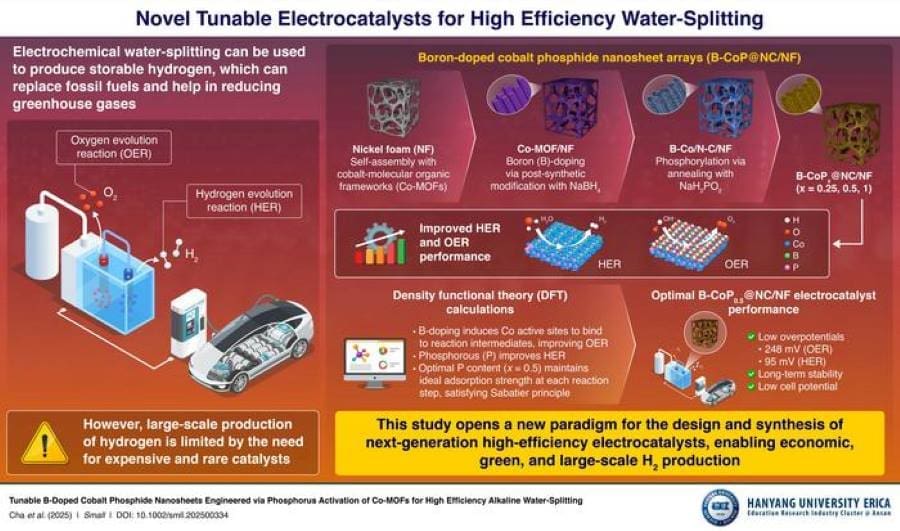Summary:
Producing green hydrogen at scale has long been held back by the need for costly rare earth metals in the water-splitting process. Now, scientists at Hanyang University ERICA in South Korea have developed a low-cost alternative that could bring affordable, efficient hydrogen production closer to reality.
In a study published in the journal Small, Professor Seunghyun Lee and his team report the development of a new boron-doped cobalt phosphide (CoP) catalyst that performs exceptionally well in both key steps of electrochemical water-splitting: the hydrogen evolution reaction (HER) and the oxygen evolution reaction (OER).
The research team synthesized nanosheets of the catalyst using cobalt-based metal-organic frameworks (MOFs) modified with boron and phosphorus. The resulting electrocatalyst demonstrated high surface area, mesoporous structure, and outstanding stability. In performance tests, the most effective variant achieved notably low overpotentials, 248 mV for OER and 95 mV for HER, significantly outperforming many conventional materials. A full alkaline electrolyzer using this catalyst required just 1.59 V at 10 mA cm-2 and maintained its efficiency for over 100 hours.
The results, supported by density functional theory calculations, suggest a viable path to cheaper green hydrogen production, potentially reducing global carbon emissions and supporting a shift to cleaner energy systems.

Hanyang University researchers discovered new breakthrough catalyst for cheaper green hydrogen production
To reduce greenhouse gas emissions and combat climate change, the world urgently needs clean and renewable energy sources. Hydrogen is one such clean energy source that has zero carbon content and stores much more energy by weight than gasoline. One promising method to produce hydrogen is electrochemical water-splitting, a process that uses electricity to break down water into hydrogen and oxygen. In combination with renewable energy sources, this method offers a sustainable way to produce hydrogen and can contribute to the reduction of greenhouse gases.
Unfortunately, large-scale production of hydrogen using this method is currently unfeasible due to the need for catalysts made from expensive rare earth metals. Consequently, researchers are exploring more affordable electrocatalysts, such as those made from diverse transition metals and compounds. Among these, transition metal phosphides (TMPs) have attracted considerable attention as catalysts for the hydrogen generating side of the process, known as hydrogen evolution reaction (HER), due to their favorable properties. However, they perform poorly in the oxygen evolution reaction (OER), which reduces overall efficiency.
Previous studies suggest that Boron (B)-doping into TMPs can enhance both HER and OER performance, but until now, making such materials has been a challenge.
In a recent breakthrough, a research team led by Professor Seunghyun Lee, including Mr. Dun Chan Cha, from the Hanyang University ERICA campus in South Korea, has developed a new type of tunable electrocatalyst using B-doped cobalt phosphide (CoP) nanosheets. Prof. Lee explains, “We have successfully developed cobalt phosphides-based nanomaterials by adjusting boron doping and phosphorus content using metal-organic frameworks. These materials have better performance and lower cost than conventional electrocatalysts, making them suitable for large-scale hydrogen production.”
The researchers used an innovative strategy to create these materials, using cobalt (Co) based metal-organic frameworks (MOFs). “MOFs are excellent precursors for designing and synthesizing nanomaterials with the required composition and structures,” notes Mr. Cha. First, they grew Co-MOFs on nickel foam (NF). They then subjected this material to a post-synthesis modification (PSM) reaction with sodium borohydride (NaBH4), resulting in the integration of B. This was followed up by a phosphorization process using different amounts of sodium hypophosphite (NaH2PO2), resulting in the formation of three different samples of B-doped cobalt phosphide nanosheets (B-CoP@NC/NF).
Experiments revealed that all three samples had a large surface area and a mesoporous structure, key features that improve electrocatalytic activity. As a result, all three samples exhibited excellent OER and HER performance, with the sample made using 0.5 grams of NaH2PO2 (B-CoP0.5@NC/NF) demonstrating the best results. Interestingly, this sample exhibited overpotentials of 248 and 95 mV for OER and HER, respectively, much lower than previously reported electrocatalysts.
An alkaline electrolyzer developed using the B-CoP0.5@NC/NF electrodes showed a cell potential of just 1.59 V at a current density of 10 mA cm-2, lower than many recent electrolyzers. Additionally, at high current densities above 50 mA cm-2, it even outperformed the state-of-the-art RuO2/NF(+) and 20% Pt-C/NF(−) electrolyzer, while also demonstrating long-term stability, maintaining its performance for over 100 hours.
Density functional theory (DFT) calculations supported these findings and clarified the role of B-doping and adjusting P content. Specifically, B-doping and optimal P content led to effective interaction with reaction intermediates, leading to exceptional electrocatalytic performance.
“Our findings offer a blueprint for designing and synthesizing next-generation high-efficiency catalysts that can drastically reduce hydrogen production costs,” says Prof. Lee. “This is an important step towards making large-scale green hydrogen production a reality, which will ultimately help in reducing global carbon emissions and mitigating climate change.”
Journal Reference:
D. C. Cha, J. H. Seok, S. C. Cho, M. Singh, T. I. Singh, S. U. Lee, S. Lee, ‘Tunable B-Doped Cobalt Phosphide Nanosheets Engineered via Phosphorus Activation of Co-MOFs for High Efficiency Alkaline Water-Splitting’, Small 2500334 (2025). DOI: 10.1002/smll.202500334
Article Source:
Press Release/Material by Industrial Cooperation & research Planning team | Hanyang University ERICA
Featured image credit: Lanju Fotografie | Unsplash




